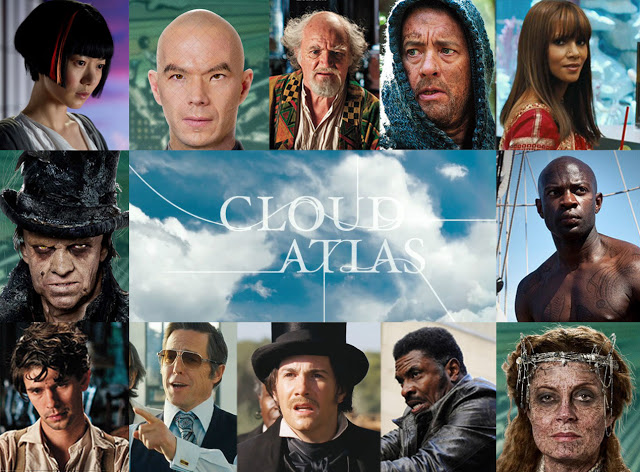 |
| But how can a film with so many actors playing so many different roles go wrong? |
Cloud Atlas, directed by the Wachowskis and Tom Tykwer, portrays the pursuit of equality in a palatable way for the mainstream – soaked with platitudes. But, due to facially disproportioned prosthetics and a failed attempt at a postmodern structure it misses even the mainest of mainstreams. Tom Hanks, Halle Berry and a slew of other actors don different noses, teeth and skin colors to represent parallel souls traveling through generations of personal and cultural strife. Each protagonist challenges an authority or oppressive obstacle.
Cloud Atlas tries to transgress norms, but it fails because it spends too much time celebrating gimmicks. Even though it pushes an over-sentimental philosophy – I still want to like it because it tries to present a variety of underrepresented ideas and identities. But, I just can’t like the movie because the structure and devices weaken it.
We get several solid female characters, a tender and sympathetic portrayal of gay lovers and plenty of conversations (directly and indirectly) about the importance of empowering marginalized groups.
Berry plays (among other characters) a journalist in 1973, Luisa Rey, investigating a nuclear plant. She’s smart, complex and is following a story rather than romantic interest. She’s not a kickboxing Buffy-esque strong woman, but a typical adept character with strengths, flaws and personality.
We see a similar level of complexity in the relationship between two men in 1936 who are young and in love, but separated while one, Robert Frobisher (Ben Whishaw), unsuccessfully pursues his ambitions as a composer. They don’t have an ideal romance, and we only see them actually together once, but their affair may be the most intense of the film. They do not dwell on societally-imposed secrecy about their sexuality, but it is painfully clear what limits them. Also, while their story does end tragically, it is not because of sexuality, but because of Frobisher’s failed ambitions. It could be argued that the characters are experiencing indirect punishment for their sexuality – but their story isn’t the only tragic one, and their affection for each other is the happiest part of Forbisher’s narrative.
Also, we follow the story of a young American attorney who agrees to help a black man escape slavery and subsequently becomes an abolitionist. We also follow a commodified woman escape from slavery and fight against fascism in a dystopian world. These are cookie-cutter liberal narratives – not progressive. But, put together they create a tone that celebrates marginalized people rising up and making their voices heard.
Because the ideas behind the film are embracing multiculturalism I am also reluctant to say that actors playing different races is problematic. It doesn’t feel offensive against a back-drop of social justice themes – as much as naïve. Most of the main characters already share an easily identifiable birthmark – so there is no need for the characters to be played by the same actors. The birthmark itself could be heavy-handed, but the characters being played by the same actors puts it over the top. If the make-up had been skillfully done, it might be more compelling, but when Hanks plays a 19thcentury doctor, he has a clumsy set of fake teeth slapped under false freckles and complimented by a trying-too-hard nasally English accent (the accent is not the make-up artists’ fault, but it sure does negatively enhance the overall effect). All of the make-up looks hastily thrown together. And, reading an interview with the make-up artist backs up that idea.
Jeremy Woodhead, a make-up designer for the film, detailed his process in an interview with the Los Angeles Times.
“Susan Sarandon was away filming somewhere else, so we hadn’t got a life cast, and I had to turn her into a little old man from the Indian subcontinent. So I used James D’Arcy’s eyebrow blocker piece to change the shape of her forehead. On top of that, I put Jim Sturgess’ forehead. And I had two or three noses made of varying sizes, just hoping that one would fit. Luckily, one did. And then put a wig and a goatee beard and a mustache and then just a lot of paintwork on her. This was the first time she’d ever been a man, and she just sat there giggling.”
Cloud Atlas looks like it is begging to be dubbed “groundbreaking” and reviewed with clichés intimating its unique and fresh take on culture. But, it’s just an over-layered overlapping story making comfortable stabs at conformity and glossy-eyed statements about the connectedness of all humans.
This is the trouble with unremarkable films; no matter how good the intention of their message – it will go unheard if communicated poorly.
